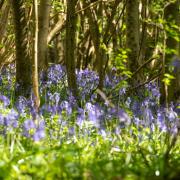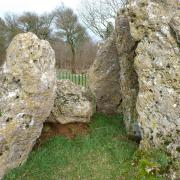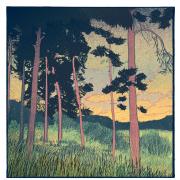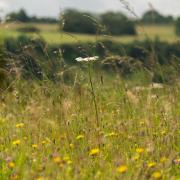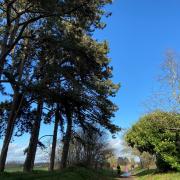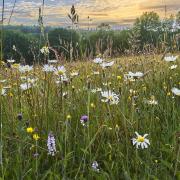For a couple of small villages on the edge of Gloucestershire, Dymock and Kempley have quite a lot of claims to fame.
Daffodils, poets, a mini-cathedral of the Arts and Crafts Movement, a painted church and a couple of much darker tales of curses and burials.
Our walk starts in Dymock by the Beauchamp Arms. Dymock became known for the group of poets who moved to the area from 1911. Lascelles Abercrombie was followed by Wilfrid Gibson, Robert Frost and Edward Thomas with visits from John Drinkwater, Rupert Brookes and Eleanor Farjeon. You may well find the men in the church: lovely knitted figures of each of them (time for someone to knit a Farjeon?) with a display about them. For these writers and poets, Dymock and the surrounding area was a golden corner of England, full of flowers and sunlight and the memory of the time before the First World War, but Dymock does have a dark history, too, and I’ll share that as we weave through the flowers and churches.

Head up the road, crossing the brook, and turn left onto a footpath by some buildings. You’re now on the Daffodil Way. If you’re quick and pop straight out to do the walk, you might just see the daffs this year, if not – watch out for the bluebells! We’ll follow the Way over the brook to a road, then back up through Allum’s Grove and on towards St. Mary’s church in Kempley. As you walk through the spring flowers, spare a thought for Sarah Ellis – and these thoughts are best had in the sunshine, as poor Sarah Ellis was cursed. How do we know? Because a curse tablet, bearing her name, but backwards, ‘haras Sille’ was found in 1892 in Dymock. It’s now in Gloucester Museum.

The tablet dates from the late 17th century, and looks like a classic bit of witchcraft. It has symbol representing the spirits of the moon and has written on it this script: ‘Hasmodait, Acteus, Magalesius, Ormenus, Leius, Nicon, Minon, Zeper make this person to banish away from this place and Country, amen. To my desier amen’. The anonymous hater may have taken the text from Henry Cornelius Agrippa's Fourth Book of Occult Philosophy, which was translated into English in 1655. Agrippa was a 16th-century soldier and philosopher. Cursing is certainly nothing new – even in the Cotswolds we have evidence of it, also inscribed on lead, from Roman visitors to Bath! In the 17th century, people were creating a lot of protective magical objects – you might counter a curse like this by creating a witch bottle to trap the witch with maybe their hair or nail clippings – or other things of a personal nature! There’s an example in the Pitt Rivers Museum in Oxford. These protective magics are actually much more common than finding destructive ones like the curse tablet.
But who was Sarah Ellis? What had she done to inspire the curse writer? That we don’t know, but there is a local legend that says she was so distressed by this curse that she took her own life. She was buried at a crossroads – so that her spirit could not find its way home – with a stake through her heart for good measure. There is an Ellis Cross between Dymock and Oxenhall. But you’ll be happy to know that there are two Sarah Ellises in the parish records, and neither suffered any such trauma!

By now you’ll be approaching the old church at Kempley, now rather far away from the village centre. Perhaps we’ll find succour from such a dark story here? St Mary’s is renowned for its wonderful scheme of medieval wall paintings, which date from the 13th to the 15th centuries. Among them is a Wheel of Life, reminding the medieval parishioners that life ultimately ends in death – a tomb sits at the bottom of the wheel, so maybe not so cheerful after all. Although of course for not only the medieval parishioners but the 17th-century ones, too, they had hope of salvation. The wall paintings themselves are a remarkable survival – hidden during the Reformation by whitewash, they were only rediscovered in 1871 by the then curate Arthur Hislop Drummond.
From the church we then pick up the Three Choirs Way past the front of Kempley Court along a brook to a T-junction, turning right on the road and heading into Kempley village and the Arts and Crafts church built by Randall Wells at the instigation of the lord of the manor, the 7th Earl Beauchamp, in 1902. This simple church offers a contrast to the lavishly decorated St. Mary’s, although the rood of a doll-like Christ flanked by Mary and St. John the Evangelist, carved by the last ship’s figurehead carver in London, was a source of controversy, turfed out by the bishop who found it far too Catholic for his liking. This passed, and the figures were reinstated. But why was the vicar of Kempley treated to three nights of rough music – parishioners blowing trumpets, beating drums and shaking pebble-filled kettles?
We turn towards Dymock again, heading down the road through Kempley Green. Just past the small brick Bethel Chapel, turn left down a lane, then right on the Daffodil Way once more. There is another dark tale of Dymock, though it’s perhaps rather a case of mistaken offence than anything worse. This is the once-famous tale of the ‘man without a shirt’. The late 19th century was a harsh time, with no support for those who became ill. A man, Robert Meredith from the Forest of Dean, working at a Dymock farm hanged himself in 1879 to save himself from the worse fate of the workhouse. Suicides were still denied proper burial in those days, and the poor man had then to be buried, without a coffin or shroud, in the dark of the night in the supposedly less lucky north side of the churchyard. It’s said a laundress in the village took pity on him and fashioned a shroud out of two sheets, but that’s not what was said later on.
The man’s relatives came to fetch his body, and spread the word that he’d been buried in nothing but a bit of old sacking! From that time on the folk of Dymock were loathed by the Foresters. This is seen in F W Harvey’s poem, Warning, of 1926, which talks about the dangers of mentioning certain things to certain villagers – such as the bears at Ruardean, and the pig placed on the wall to watch the band go by at Yorkley Slad:
And if your feet so far should stray
As Dymock, lest some hurt
Befall you, make no mention of
The man without a shirt.
Meredith himself did not rest easy, and the barn where he hanged himself is said still to be haunted.
Follow the Daffodil Way through Dymock Wood down to the M50, then turn back up towards Dymock, emerging back on the road by the Beauchamp Arms. Rivalry between villages was a very real thing, and Dymock shares the fate of several villages and towns in Gloucestershire as village of ‘sillies’ or fools, alongside Ebrington, Willersey, Drybrook and my own Stroud, as it’s also the location of a treacle mine. Not so long ago, lorry drivers would ask directions to them at the pub in jest and with equal humour would be sent on their merry way. Real treacle? No, of course not! What then? Maybe retted down flax to make linen thread, or straw used in World War Two to make paper – both of which look thick and viscous. Or maybe it was a treacle well as the word ‘treacle’ once meant medicine in Britain making a healing well a treacle well, like the other one in our area, at Binsey in Oxford. But is there a holy well in Dymock? If there was, it’s not on the map today – so we have to content ourselves with poetry, flowers – and curses.
ESSENTIALS
Distance: 8.25 miles
Duration: 5 hours.
Parking: Road parking in Dymock
Toilets and refreshments: Beauchamp Arms, Dymock
Transport links: 456 bus between Newent and Hereford.
Further reading: The Folklore of Gloucestershire, by Roy Palmer, who lived in Dymock.
LINKS
Route: gb.mapometer.com/walking/route_5431409
Friends of the Dymock Poets: dymockpoets.org.uk
St. Mary, Kempley: www . english-heritage.org.uk/visit/places/st-marys-church-kempley
Kempley: kempleytardis.org.uk
Kirsty Hartsiotis is based in Stroud and available for hire as a storyteller and speaker. She is an Accredited Arts Society lecturer. Her books include Wiltshire Folk Tales and (with Anthony Nanson) Gloucestershire Ghost Tales and Gloucestershire Folk Tales for Children. She is also the curator of decorative art at a Gloucestershire museum.
READ MORE: The 10 mile circular walk near the Cotswolds around the Daffodil Way









